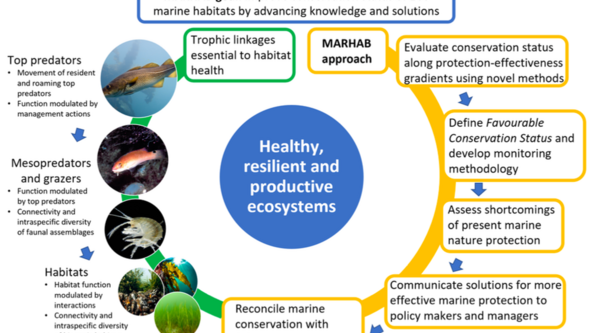MARHAB
Short description
MARHAB’s goal is to improve the conservation status of marine ecosystems in the Kattegat-Skagerrak region and beyond by applying an ecosystem perspective on the ability to restore and maintain marine habitats.
About the project
Marine habitats are under pressure. Although the EU Habitats Directive was agreed upon 30 years ago, the vast majority of marine habitats and species protected under the Directive still show an unfavourable conservation status. This situation is particularly pressing in Northern Europe, where the conservation status of marine habitats in the Kattegat-Skagerrak region is consistently bad. Available evidence shows that the status of these habitats is tightly linked to fisheries, both via the direct physical impact of fishing, but importantly also via indirect effects, where loss of large predatory fish and their regulating role causes so-called “trophic cascades”, perturbing through the ecosystem and leading to a deterioration of benthic habitats. It is obvious that the applied conservation measures have not been sufficient to halt these devastating effects of fishing and other anthropogenic pressures on the protected habitats. To prevent further biodiversity decline in these habitats there is an urgent need to (1) incorporate and disseminate the role and importance of trophic dynamics in maintaining habitat function and health, and (2) reconcile fisheries management with conservation of biological diversity.
MARHAB’s goal is to improve the conservation status of marine ecosystems in the Kattegat-Skagerrak region and beyond by applying an ecosystem perspective on the ability to restore and maintain marine habitats protected under the EU Habitats Directive, and further by demonstrating pathways to improve the definition of “favourable conservation status” of these and similar habitats (Figure at the top of the page). MARHABs ambition is to promote ecosystem dynamics and trophic linkages considered essential to habitat health and contribute to fast-tracking the highly overdue reconciliation of marine biodiversity conservation with fisheries management. We deem it urgent to make use of available science pointing to the central function of top predators for maintaining and restoring habitat health and resilience in temperate marine ecosystems. This will only be possible through a full appraisal of fishing as a major driver of change in marine ecosystems.

Centre bubble: the vision of the project is to contribute to achieving healthy, resilient, and productive ecosystems. Left side of circle: example of linkages between trophic groups involved in ecosystem interactions essential to maintain habitat health. Right side of circle: MARHAB’s approach to bringing about our vision statement.
The 4-year Horizon Europe project is a collaboration between: The Institute of Marine Research (Norway, Coordinator), University of Gothenburg (Sweden), SLU (Sweden), DTU (Denmark), University of Algarve (Portugal) and CNRS (France). The Gothenburg University team will be focusing on connectivity and intraspecific diversity of biogenic habitats, and also on the movement and trophic connections between top predators and habitats.
